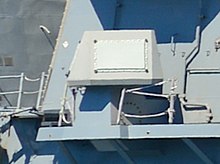|
AN/SLQ-32 electronic warfare suite The AN/SLQ-32 is a shipboard electronic warfare suite built by the Raytheon Company of Goleta, California and The Hughes Aircraft Company.[1] It is currently the primary electronic warfare system in use by U.S. Navy ships.[2] Its operators commonly refer to it as the "Slick-32".[3] Variants
 The SLQ-32 was originally conceived in the 1970s to augment the AN/WLR-1, which had been in service since the early 1960s. It was later determined to save costs to replace the various WLR-1 series suites with the SLQ-32 as a stand-alone system. As originally designed, the SLQ-32 was produced in three variants, the (V)1, (V)2 and (V)3. Later in its service life, additional versions were built, the (V)4 and (V)5. Today, (V)6 and (V)7 versions are in production. The Air Transport Rack sized processors were supplied by ROLM Mil-Spec Computers in San Jose, California.


All versions of the SLQ-32, with the exception of the (V)4, are interfaced with the Mk 36 Decoy Launching System, able to launch chaff and infrared decoys under the control of the SLQ-32. A growing number of systems are being upgraded to incorporate the Australian-designed Mk 53 Nulka decoy launching system.[4][8] The original modular design was intended to allow upgrades of the system from one variant to the next by simply installing additional equipment as required. Starting in the early 1990s, a program was begun to upgrade all SLQ-32s in the U.S. fleet. Most (V)1 systems were upgraded to (V)2, and most (V)2 systems were upgraded to (V)3. This was normally carried out during a major ship overhaul. SEWIP Block 2 was tested on USS Freedom in December 2014,[9] and as of 2022, the latest U.S. destroyers are fitted with (V)6. In 2023, USS Pinckney became the first destroyer fitted with SEWIP Block 3.[8] Contract The initial procurement process was built around a “design to price” concept in which the final delivery cost per system was fixed in the contract. The SLQ-32 was designed to support the protection of ships against anti-ship missiles in an open sea environment. After initial deployment of the system, naval roles began to change requiring ships to operate much closer to shore in denser signal environments. This change in roles required changes to the SLQ-32 systems which were added over time. With experience gained working with the SLQ-32, coupled with improvements to the hardware and software, technicians and operators gradually overcame the initial problems. The SLQ-32 is now the mainstay of surface electronic warfare in the U.S. Navy and U.S. Coast Guard's WMEC 270-foot (82 m)-class ships. Future In 1996, a program called the Advanced Integrated Electronic Warfare System (AIEWS) was begun to develop a replacement for the SLQ-32. Designated the AN/SLY-2, AIEWS reached the prototype stage by 1999, but funding was withdrawn in April 2002 due to ballooning costs and constant delays in the projects development. It has since been replaced with Surface Electronic Warfare Improvement Program (SEWIP), which will replace the existing SLQ-32 hardware and technology in an evolutionary fashion.[10] As of September 2013[update], SEWIP Block 2 upgrades were first installed on Arleigh Burke-class destroyers in 2014, with full-rate production scheduled for mid-2015.[11] Block 2 improved detection capabilities; better jamming is planned from 2017, but the 2013 sequestration cuts may push this date back a year.[12] As of November 2023, SLQ-32(V)7 (SEWIP Block 3) is undergoing low-rate initial production and being retrofitted on Flight IIA Arleigh Burke-class destroyers, replacing their existing SLQ-32 equipment.[6][5] A future SEWIP Block 4 with electro-optic and infrared detection capabilities has been proposed.[10] In September 2023, the first SEWIP Block 3 was fielded on USS Pinckney.[13] See also
References
External links |
